
Common Chinese Coins Used in I Ching Divination
- By YOWAYOW
Not all coins need to be ancient.
To begin with, any coin that has a distinguishable front and back can be used for I Ching divination. The key is not the coin itself, but the ability to clearly tell the difference between the two sides — because the essence of I Ching lies in distinguishing yin (阴) and yang (阳).
As long as you can divide an object into two distinct states — yin and yang — it can be used for divination. This means that even a leaf, a piece of paper, or a stone could theoretically work.
Want to learn how to read hexagrams after casting coins?
See this guide:
👉 https://yowayow.com/i-ching-divination-for-beginners-how-to-use-coins-and-interpret-hexagrams/
If you prefer something more intuitive and not too complex,
You can simply purchase our ready-to-use I Ching oracle cards:
👉 https://yowayow.com/product/yowayow-tao-fortune-cards/
Ritual or Realness? You Choose.
But if you’re someone who values the ceremony and symbolism behind traditional I Ching casting, then Chinese coins are essential. This article introduces common coin types you can find through online marketplaces. We also plan to launch our own line of quality-checked coins soon — stay tuned!
A Note About Authenticity
If you’re outside of China, any Chinese coins legally available for sale are reproductions, not ancient artifacts. According to Chinese government regulations, authentic old coins are not permitted for export. (The coins we will soon offer are also modern reproductions.)
About Chinese Coin Production
China has a well-established industry for producing replica coins. Based on the copper material, purity, size, craftsmanship, and surface designs, there are countless styles to choose from — whether for decoration, Feng Shui, divination, or handmade crafts.
This guide will be continually updated to provide you with historical context and practical insights for the most commonly seen coin types.
1. Categorized by Historical Dynasties
▸ Qin Dynasty: Ban Liang (半两)
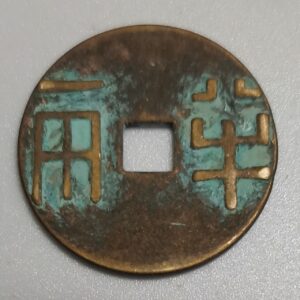
“Ban Liang” was the standard copper coin introduced by Emperor Qin Shi Huang when he unified China. It is round with a square hole, symbolizing “Heaven is round, Earth is square.” These coins are thick, simple in inscription, and represent China’s earliest national currency.
▸ Han Dynasty: Wu Zhu (五铢)
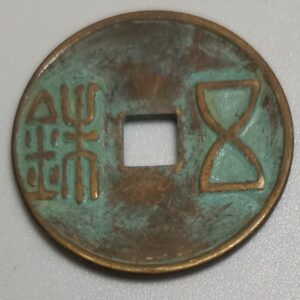
Introduced under Emperor Wu of Han, Wu Zhu coins became the longest-used coin in Chinese history, lasting over 700 years. “Zhu” is a unit of weight; the coin’s size and weight were consistent, with increasingly refined craftsmanship.
▸ Tang Dynasty: Kai Yuan Tong Bao (开元通宝)
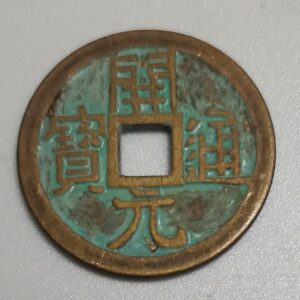
Minted by Emperor Gaozu during the Kaiyuan era, it was the first coin to use the term “Tong Bao” (通宝, meaning “currency”) — a naming tradition that continued for centuries. The calligraphy is considered a masterpiece of regular script (楷书).
▸ Song Dynasty: Various Coins
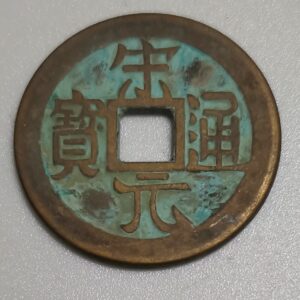
The Song Dynasty produced a wide variety of coins, such as Song Yuan Tong Bao (宋元通宝), Chong Ning Zhong Bao (崇宁重宝), Da Guan Tong Bao (大观通宝), etc. It was the first dynasty to widely use iron coins, and experimented with different scripts including seal script and clerical script.
▸ Yuan Dynasty: Zhong Tong Yuan Bao (中统元宝)
Yuan Dynasty used both paper money and coins. Their coins reflect a blend of Mongolian and Han aesthetics, though they are less refined than earlier dynasties.
💬 Note: Due to Yuan’s historical and cultural associations (Mongol rule), Taoist or spiritual practitioners tend to avoid Yuan-era coin designs, so they’re rarely reproduced or sold.
2. Five-Emperor Coins (五帝钱 – Wǔ Dì Qián)
The “Five-Emperor Coins” refer to coins from five prosperous emperors of the Qing Dynasty, believed to carry powerful positive energy (righteous Qi) due to their long reigns and national stability. These are commonly used for Feng Shui, protection, and good fortune:
- Shunzhi Tongbao (顺治通宝): Simple and solid in style; used for invoking new beginnings and smooth progress.
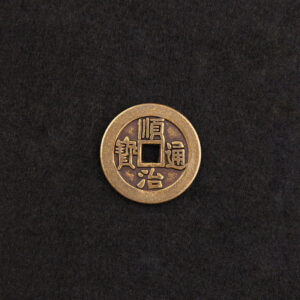
- Kangxi Tongbao (康熙通宝): Widely produced; most commonly used among the Five Emperors.
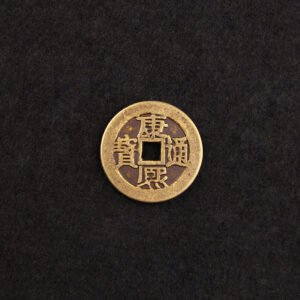
- Yongzheng Tongbao (雍正通宝): Sleek calligraphy; moderate in rarity.
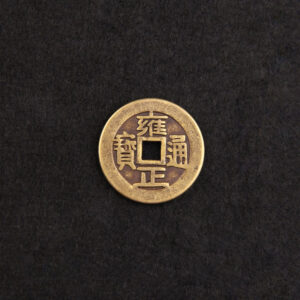
- Qianlong Tongbao (乾隆通宝): Symbolizes wealth, longevity, and family harmony.
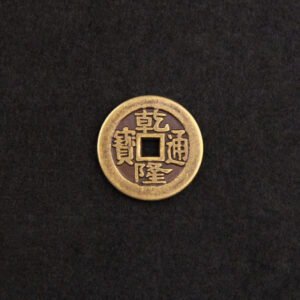
- Jiaqing Tongbao (嘉庆通宝): Represents stability and household peace.
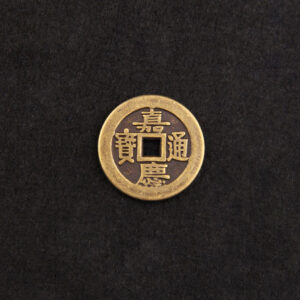
3. Other Qing Dynasty Coins
Aside from the Five Emperor coins, the Qing Dynasty also minted a large number of coins under other reign titles. These are also commonly used in Feng Shui rituals or historical collections:
- Daoguang Tongbao (道光通宝): Thick strokes and a humble, grounded appearance.
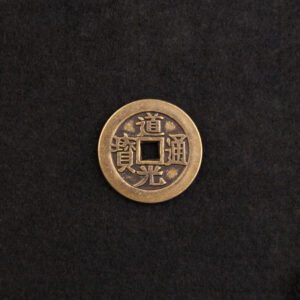
- Xianfeng Tongbao / Zhong Bao (咸丰通宝 / 重宝): Minted in various denominations (small, tenfold, fiftyfold, etc.), with size increasing by value.
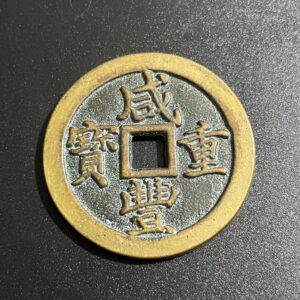
- Tongzhi Tongbao (同治通宝), Guangxu Tongbao (光绪通宝): Fine craftsmanship and frequently used in modern spiritual practices.
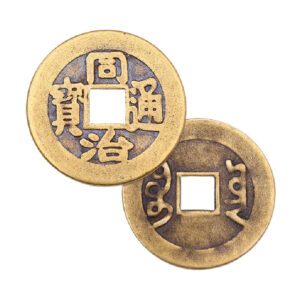
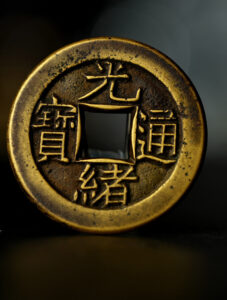
4. Shan Gui Hua Qian (山鬼花钱) – “Mountain Spirit Coins”
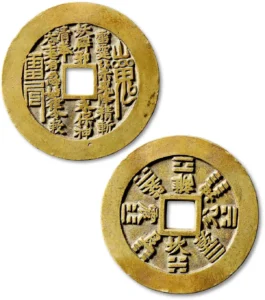
These are non-circulating decorative coins, made by folk craftsmen in ancient times. They often feature mythical figures, Taoist symbols, or talismanic motifs used for protection, blessing, or burial rites.
- Common imagery: Mountain spirits, Bagua (八卦), tigers & dragons, thunder gods, sun and moon deities
- Uses: Worn as amulets, placed in tombs, displayed on altars, or embedded in protective charms
- Typical phrases: “Ward off evil (避邪镇宅)”, “No harm shall come (百无禁忌)”, “Longevity and fortune (福寿安康)”
5. Zhusha Shan Gui Hua Qian (朱砂山鬼花钱) – Cinnabar-Coated Spirit Coins
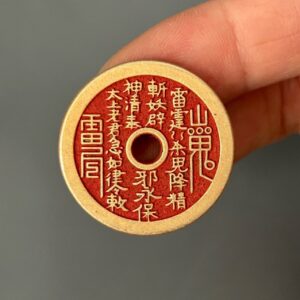
These are Shan Gui coins coated or soaked in natural cinnabar (朱砂 – zhūshā), which is considered the most yang (阳) and protective substance in Chinese metaphysical tradition.
- Bright red color: Visually striking, full of yang energy
- Used in: Taoist rituals, altar offerings, exorcism, spiritual practices
- Can be: Hung over doorways, worn as a pendant, placed on altars or used in energy grids
- Often combined with: Cinnabar talismans, Bagua mirrors, Five-Emperor Coins for enhanced effect
Want to explore more cards?
See the full list of I Ching Hexagrams →
All predictions and interpretations on this site are purely for entertainment purposes and should not be taken seriously.
If you have a personal question or dilemma, you’re welcome to submit it.
We choose a few questions to respond to from time to time. Some of these may be featured on our blog, anonymously.
Please note:
Not every question will receive a response.
There is no cost to submit a question.
Responses are intended to inspire reflection, not provide absolute answers.
If selected, your question may be shared on the site, without any identifying information.
Submit your question via email: ask@yowayow.com
By submitting, you agree that your question may be used for public exploration on our site, anonymously and respectfully.